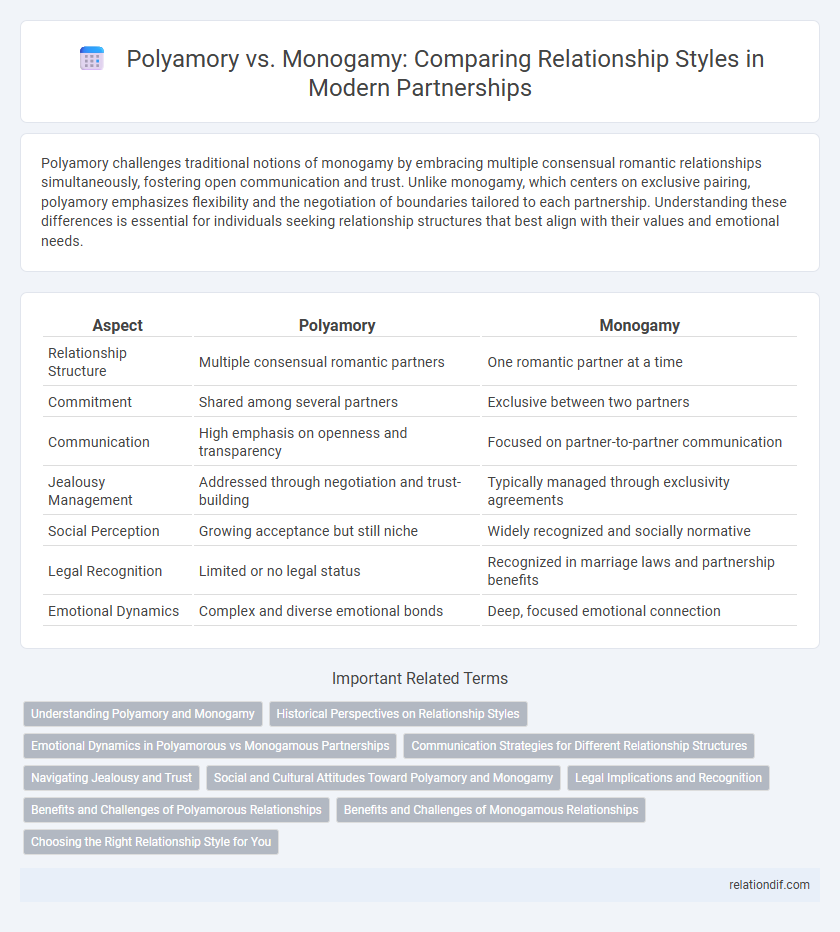Polyamory challenges traditional notions of monogamy by embracing multiple consensual romantic relationships simultaneously, fostering open communication and trust. Unlike monogamy, which centers on exclusive pairing, polyamory emphasizes flexibility and the negotiation of boundaries tailored to each partnership. Understanding these differences is essential for individuals seeking relationship structures that best align with their values and emotional needs.
Table of Comparison
| Aspect | Polyamory | Monogamy |
|---|---|---|
| Relationship Structure | Multiple consensual romantic partners | One romantic partner at a time |
| Commitment | Shared among several partners | Exclusive between two partners |
| Communication | High emphasis on openness and transparency | Focused on partner-to-partner communication |
| Jealousy Management | Addressed through negotiation and trust-building | Typically managed through exclusivity agreements |
| Social Perception | Growing acceptance but still niche | Widely recognized and socially normative |
| Legal Recognition | Limited or no legal status | Recognized in marriage laws and partnership benefits |
| Emotional Dynamics | Complex and diverse emotional bonds | Deep, focused emotional connection |
Understanding Polyamory and Monogamy
Polyamory involves engaging in multiple consensual romantic relationships simultaneously, emphasizing open communication, trust, and ethical boundaries. Monogamy centers on a committed relationship between two partners, focusing on exclusivity and deep emotional connection. Understanding the dynamics, benefits, and challenges of both relationship styles is crucial for fostering respect and compatibility in any partnership.
Historical Perspectives on Relationship Styles
Historical perspectives on relationship styles reveal that polyamory and monogamy have evolved through diverse cultural and social frameworks. Ancient civilizations like the Greeks and Romans often accepted polyamorous arrangements, while many societies have traditionally promoted monogamous unions rooted in religious and legal institutions. Modern shifts continue to challenge and redefine the boundaries of these relationship models, reflecting broader changes in societal values and individual autonomy.
Emotional Dynamics in Polyamorous vs Monogamous Partnerships
Emotional dynamics in polyamorous partnerships involve managing multiple intimate connections, requiring advanced communication skills, empathy, and boundary setting to navigate complex feelings such as jealousy and insecurity. In contrast, monogamous partnerships often center emotional energy and commitment on a single partner, fostering deep exclusivity and prioritizing intimacy through shared experiences and mutual trust. Research indicates polyamorous individuals may develop heightened emotional resilience and interpersonal skills due to the necessity of balancing diverse relational needs.
Communication Strategies for Different Relationship Structures
Effective communication strategies vary significantly between polyamorous and monogamous relationships due to their distinct structural dynamics. Polyamorous partnerships prioritize multi-channel dialogue, explicit boundary-setting, and regular check-ins to manage multiple emotional connections simultaneously. Monogamous relationships often emphasize deep emotional intimacy, conflict resolution skills, and consistent transparency to maintain mutual trust and exclusivity.
Navigating Jealousy and Trust
Navigating jealousy and trust in polyamory requires clear communication, setting boundaries, and fostering emotional transparency to ensure all partners feel valued and secure. Monogamous relationships often rely on exclusivity and consistent reinforcement of commitment to build trust and mitigate jealousy effectively. Both relationship styles benefit from active empathy and ongoing dialogue to address insecurities and strengthen connection.
Social and Cultural Attitudes Toward Polyamory and Monogamy
Social and cultural attitudes toward polyamory and monogamy vary widely, with monogamy predominantly favored due to longstanding traditions and legal frameworks in many societies. Polyamory challenges conventional norms by promoting multiple consensual relationships, often facing stigma and misunderstanding despite growing acceptance in progressive communities. Media representation and legal recognition continue to influence public perception, gradually shifting cultural openness toward diverse partnership structures.
Legal Implications and Recognition
Legal recognition of monogamous partnerships remains standard in most jurisdictions, granting spouses rights related to inheritance, taxation, and decision-making. Polyamorous relationships often lack explicit legal status, resulting in challenges such as limited access to spousal benefits and complex custody disputes. Courts are increasingly facing cases involving polyamory, prompting evolving discussions about expanding legal frameworks to accommodate diverse partnership structures.
Benefits and Challenges of Polyamorous Relationships
Polyamorous relationships offer benefits such as enhanced emotional support networks, increased communication skills, and diverse expressions of love that can lead to personal growth. Challenges often include navigating jealousy, managing complex time commitments, and addressing societal stigma, which require strong trust and clear boundaries. Effective communication and mutual respect are critical for maintaining balance and ensuring the well-being of all partners involved.
Benefits and Challenges of Monogamous Relationships
Monogamous relationships offer emotional security by fostering deep trust and exclusive commitment between partners, which can enhance long-term stability. Challenges include potential risks of dependency and limited social experiences, which may lead to feelings of confinement or unmet emotional needs. The clear structure of monogamy simplifies relationship management but requires continuous communication to address evolving expectations and maintain mutual satisfaction.
Choosing the Right Relationship Style for You
Choosing the right relationship style depends on personal values, emotional needs, and communication preferences. Polyamory offers flexibility and multiple intimate connections, while monogamy provides exclusivity and deep commitment. Evaluating compatibility, boundaries, and long-term goals ensures a fulfilling partnership aligned with individual desires.
polyamory vs monogamy Infographic

 relationdif.com
relationdif.com